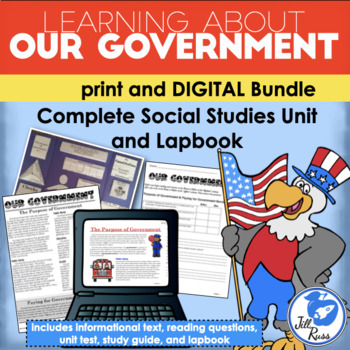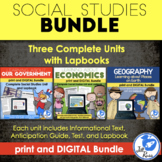Government Unit, Lapbook, Text Print & Digital Distance Learning Bundle
- Zip
- Google Apps™

What educators are saying
Products in this Bundle (2)
Also included in
- Everything you need for third grade social studies curriculum in one giant bundle! This mega bundle contains 10 complete units, to teach a complete year of social studies! Save BIG by buying them together! Check out the links to the individual products for more previews.This Social Studies Mega-BunPrice $81.55Original Price $116.50Save $34.95
- Everything you need for your social studies curriculum in one ultimate super bundle! This Ultimate bundle contains ALL third-grade social studies materials that I've created. You get all of my social studies products in one place! This bundle has 12 complete units and 12 lapbooks for social studiesPrice $115.15Original Price $164.50Save $49.35
- Make teaching social studies easier and engage your students! Your students will learn about geography and basic map skills, economics, and government in these three complete units--with both print and digital options--including an informational text you can use either in place of or in addition toPrice $37.20Original Price $46.50Save $9.30
Description
Your students will learn about the United States Government in this complete unit--with both print and digital options--including an informational text you can use either in place of or in addition to your textbook. You can use the printable versions, go completely paperless, or use a combination of both!
This is a complete unit with informational text, anticipation guide with questions to guide their reading, a 24 question test, and pieces for an interactive notebook or lapbook. It also includes a digital version of the student text with the reading questions that the students can complete online using Google Slides. The unit test comes in a printable version and in a Google Forms version that is graded automatically.
This Government Unit includes a 7-page informational text. This complex text will provide your students with information about the purpose of government, government services, the Constitution as the basis for our government, the three branches of government, the duties and responsibilities of each branch, qualifications for office, checks and balances, the balance of power, how our laws are made, local and state government, actions of citizens, and the meaning of the Preamble.
The Government Unit informational text is perfect for meeting your Common Core Reading Standards!! I wrote this Government Unit because I couldn't find anything rigorous enough for my third-graders! All of the other government units (and even our social studies textbook!) were too simple, and didn't meet the new demands of the Common Core for informational text. This text will provide your students with a complex, rigorous text, but the text features and other aspects will allow your third, fourth, and fifth grade students to be successful in reading and comprehending the information.
The Government Unit also includes a unit test and a study guide. There is a packet with an anticipation guide and questions to guide your students as they read each section of the informational packet. All answer keys are included.
As your students read and learn about the government, they will complete 14 different foldable pieces to make a lapbook about our government. Lapbook pieces can also be used in an interactive social studies notebook. All templates are included for the lapbook. Lapbook pieces are great for formative assessment as you work through the unit. At this time, the lapbook is only in printable format.
Lapbook or notebook pieces include foldables for:
Purpose of Government
Government Services
Paying for Government Services
Creating Our Government
Branches of Government
Legislative Branch
Executive Branch
Presidential Seal
Judicial Branch
Balance of Power
Levels of Government (2 choices)
Actions of Citizens
Standards addressed
National Standards for Civics and Government for K-4:
I. What is Government and What Should It Do?
A. What is government?
B. Where do people in government get the authority to make, apply, and enforce rules and laws and manage disputes about them?
C. Why is government necessary?
D. What are some of the most important things governments do?
E. What are the purposes of rules and laws?
F. How can you evaluate rules and laws?
G. What are the differences between limited and unlimited governments?
H. Why is it important to limit the power of government?
III. How Does the Government Established by the Constitution Embody the Purposes, Values, and Principles of American Democracy?
A. What is the United States Constitution and why is it important?
B. What does the national government do and how does it protect individual rights and promote the common good?
C. What are the major responsibilities of state governments?
D. What are the major responsibilities of local governments?
E. Who represents you in the legislative and executive branches of your local, state, and national governments?
Florida Next Generation Sunshine State Standards for Grade 3:
SS.3.C.1.1: Explain the purpose and need for government
SS.3.C.1.2: Describe how government gains its power from the people.
SS.3.C.1.3: Explain how government was established through a written Constitution.
SS.3.C.2.1: Identify group and individual actions of citizens that demonstrate civility, cooperations, volunteerism, and other civic virtues.
SS.3.C.3.1: Identify the levels of government (local, state, federal)
SS.3.C.3.2: Describe how government is organized at the local level.
SS.3.C.3.3: Recognize that every state has a state constitution.
SS.3.C.3.4: Recognize that the Constitution of the United States is the supreme law of the land.
★☆★☆★☆★☆★☆★☆★☆★☆★☆★☆★☆★☆★☆★☆★☆★☆★☆★☆★☆★☆★☆★
You may also be interested in these other resources:
$$ Buy a bundle and save! $$
MegaBundle: Regions, Economics, Government & More for 3rd grade Social Studies
Regions of the United States: 5 Complete Units Bundle
Geography Map Skills Unit & Lapbook with informational text, test, & more!}
Economics Unit & Lapbook {Complete Unit with informational text, test, & more!}
Animals: 6 Literacy Stations combining Science and Literacy for Big Kids
★☆★☆★☆★☆★☆★☆★☆★☆★☆★☆★☆★☆★☆★☆★☆★☆★☆★☆★☆★☆★☆★








